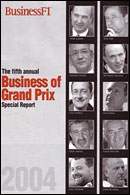
Formula One is at crossroads. External costs are up, basic income is down. As are live spectators and television viewers. The solutions are at hand, but need execution. The good news is a fairer share-out of income and a revival of the marketing services sector that has boosted overall revenues. Atlas F1 brings an excerpt of BusinessF1's fifth annual Business of Grand Prix Special Report, including the 2004 budget of the ten F1 teams
With dozens of tables and figures that provide information on sponsorship contracts, marketing figures and team budgets, the BusinessF1 special annual report - published in March every year - spans an entire magazine issue and delves in great details into every financial element of the sport.
The below article is the opening feature of the 2004 report and offers an analysis of the state of affairs in Formula One today. The article, republished by kind permission, is by no means the full report - for those interested in a more detailed analysis of each team's budgets and a complete list of sponsorship deals in Formula One as well as detailed budget analysis tables, we recommend subscribing to BusinessF1.
THE NUMBERS
The overall numbers show sponsorship and manufacturers support up, at US$1.847 billion against US$1.788 billion last year, a 3.3 per cent rise. Strip out the manufacturers' support, and pure sponsorship income for 2004 is US$943.2 million, against US$866.7 million in 2003 - an increase of 8.8 per cent. Car manufacturer support has dropped slightly, from US$922 million to US$904 million, a 1.99 per cent fall.
The biggest change year on year is the number of sponsors supporting Formula One. The sponsor roster this year has risen by 41, with 243 sponsors of the ten teams, compared with 202 in 2003, a rise of 20.3 per cent.
THE BUDGETS
All figures quoted in million US dollar
ECONOMIC OUTLOOK
Both 11th September and Schumacher's antics of 2002 have changed Formula One. They also served notice that the exclusivity era is over and the need to usher in an era of accessibility is urgent. Trouble is, the people at the top of Formula One don't seem to have worked this out. They still believe they are in the exclusivity era, whereas the truth is that they belong to an age of dinosaurs now long gone by. And it is not fair simply to blame Bernie Ecclestone and Max Mosley for this. They are to an extent creatures of the people they serve, be it circuit promoters or team principals.
Whatever the official statistics show, television viewing figures in the meaningful world are in decline. Not by much, but they are slipping a few per cent a year. Attendance figures, too, are generally waning, especially in Europe and at places like Silverstone, where the spectator figure is now smaller than at a top football match.
Licensing and merchandise sales have fallen off a cliff since 2001, down 50 per cent at least. Sponsorship is generally in decline, slipping away at the rate of five per cent a year. For every success there are two stories of failure.
The decay will continue until the current management of Formula One either does something about it, or gets a grip of the people who are stopping it, or the management is chucked out and replaced by managers who will do something about it. One or the other will eventually happen - that is the way of the world. There are good commercial managers around who can rescue Formula One. The post-Bernie era is not the wilderness that many would have us believe. In fact many believe the opposite.
POLITICS
An uneasy relationship now exists between the sport's governing body president, Max Mosley, and the team principals. In many areas of governance, such as cost-cutting, Mosley has given up, finally realising that Formula One budgets and spending are based on one fact and one fact only: the amount of money coming in. It has always been so and always will be, unless the teams themselves want change - and they don't. In many ways, wild, and often out of control spending has made Formula One what it is.
Although the much-vaunted technical changes made last year, such as the parc ferme rules, did not in the opinion of many add to the show, the changes introduced this year will - mainly by increasing the chances of retirements. Many feel the single engine rule will have to be modified to encourage more track time at F1 events. Equally the parc ferme regulations are now considered irrelevant. Mosley has also made no attempt to establish a new formula for the future. The three-litre formula is now past its sell-by-date and change is needed.
Mosley has said that he intends to stand for a new five-year term as FIA president in October 2005. If he does and is elected, by the time that term ends he will be 72 years old. It is said there will be a challenger and that some team principals may campaign against his re-election. For now that is up in the air, but during 2005 it will become more and more contentious.
PERFORMANCE
The scenario looks like staying unchanged for a few years, except that Toyota and BAR Honda will soon challenge for promotion to an expanded division one. Jordan and Minardi are stuck in division three for the foreseeable. Their problem is survival.
Another problem is the widening gap between fastest and slowest. Minardi is sinking to new lows, effectively using a 2002 design of chassis and engine. Jordan is not far behind. This has led to a worry about the slow pace of backmarkers in 2004. The 107 per cent qualifying rule was done away with in 2003, but for safety grounds a new rule may have to be introduced. 110 per cent would probably do the trick.
MANAGEMENT
All of the top eight teams in Formula One today are well managed. Gone are the Niki Laudas and the Craig Pollocks. Neither of those men had any business managing Formula One teams and it showed in their results. Of the cowboy era, only Eddie Jordan and Paul Stoddart remain. And their teams will stay glued to the bottom of the grid whilst they are in charge. Both are shrewd characters, but as far as management is concerned, they really haven't a clue. The jury is out on whether modern-day Formula One can afford characters like them. Only time can tell, but the odds are against.
Further down the chain, Ron Dennis is still training Martin Whitmarsh in his own image. And Whitmarsh undoubtedly has what it takes. Frank Williams supports Patrick Head fantastically well and Jean Todt has splendid support above and below. His boss, Luca di Montezemolo, is the best marketing brain in the paddock. Ross Brawn is the best technical organisational brain.
Briatore has all the back-up he needs from Renault, but will eventually miss Mike Gascoyne's inspiration and at some point needs to replace him.
In Nick Fry and Hugh Chambers, David Richards has back-up from two loyal colleagues, although the jury is still out on them, especially Chambers, who has to reel some sponsorship deals in soon. Tony Purnell has a good man in David Pitchforth, but he still has some hiring and firing to do elsewhere, even if he does not yet realise it.
Peter Sauber is simply a great man, full stop. Tomita has solved any problems he might have had by hiring Gascoyne. But there is no hope for Paul Stoddart or Eddie Jordan. Stoddart has never had money to try and build a management team and never will have. Jordan has had money and failed miserably. He simply does not have the management talent to manage the managers.
TECHNICAL MANAGEMENT
The calibre of technical management within Formula One is awesome, breathtaking and any other such words. Even the weakest are good.
Bob Bell, the new man at Renault, is as yet unrated from his years in Gascoyne's shadow. Sauber's Willy Rampf is not as highly regarded as others, Jordan and Jaguar's technical teams are run by committee and Gabriele Tredozi at Minardi is not regarded as a serious player.
Below the top job, McLaren has strength in depth, with Neil Oatley, Mike Coughlan and others. BMW Williams has Sam Michael, who is certainly being groomed long term to succeed Patrick Head. Ferrari does not seem to be grooming a successor to Ross Brawn and he rules supreme.
SPONSORSHIP AND FINANCE
2004 is a sweet and sour year for most of the teams. Four teams have budgets of more than US$300 million: Ferrari, McLaren Mercedes, Renault and Toyota. It used to be two but Toyota and Renault have joined the 300 club this year. Both had the foresight, or luck, to negotiate many of their sponsorship contracts in euros. The dollar's decline has made that look a spectacularly good decision in 2004.
In the next band are BMW Williams and BAR Honda. BMW Williams will almost certainly join the 300 club soon. They have an advantage in that, due to the good housekeeping of Patrick Head, their overheads are believed to be considerably smaller than most other teams.
After that, Jaguar and Sauber struggle by with a moderately-sized sum and Jordan and Minardi are permanently in purdah. For them the normal rules do not apply, it is the twilight zone.
The extent of the crisis of the weak dollar is difficult to call. The dollar has weakened by as much as 25 per cent against the euro and sterling. This means the teams that have negotiated contracts in sterling are converting the money at 25 per cent more value. But for the teams with deals in dollars, when they have to convert back to sterling or euros to cover costs, they are seeing a 25 per cent decline. That translates into a 50 per cent difference between the two sets of teams simply on a currency decision.
Some dollar losses are paper only. Converting all engine costs, generally incurred in local currencies, to dollars is one such paper loss and has artificially increased budgets. It is in fact a larger cost to car manufacturers, who inevitably see 50 per cent of income come in as dollars. And that is the money they use to pay for the engine programmes.
A smaller hit comes via a gradual 10 per cent reduction in basic TV money over 2003 due to the addition of an extra team. Toyota is now also eligible for TV payouts, whereas in 2003, after the demise of Arrows, there were only nine teams to share out the spoils.
But all that pales into insignificance with the GPWC/SLEC settlement. The settlement announced in December 2003 between GPWC Holdings BV and SLEC Holdings BV is a revolution in Formula One's finances. The settlement is encapsulated in a memorandum of understanding that will see each team get an 80 per cent rise in the level of TV fees and a one-off US$10 million flat rate sweetener in 2004.
In future, backdated to 1st January 2004, there is a formula whereby the teams will get a full 50 per cent of all the TV, hospitality and commercial revenues from Formula One instead of the 27 per cent they received in the past. In a fairer division, the GPWC (teams) and SLEC will get half of the transparent revenues. SLEC will then brush the remaining crumbs off the table to the FIA.
Ultimately GPWC will buy all the shares of SLEC Holdings, which will mean the teams getting even more. But even in 2004 the difference in TV incomes will be stark. Jordan and Minardi will get US$35 million each, mid-table teams such as BAR and Sauber will get US$40 million each and at the top Ferrari will get a mouth-watering US$55 million. McLaren and Williams will end up with around US$47 million each. In following years they will each receive US$30-US$45 million on average.
Needless to say, the extra cash has completely negated the dollar's decline, and then some. For the smaller teams such as Minardi and Jordan, it is a total lifesaver. Neither would have survived into 2004 without it. Their future is now assured and the value of the teams has risen dramatically.
This rise will inevitably be followed by a slowing down of general sponsorship levels, which all observers agree have peaked. A few teams, such as Renault, are bucking the trend but generally everyone is forecasting slight declines.
The third source of increased revenue, which affects only the smaller teams, is the vast increase in rent-a-driver fees. It was BusinessF1 that pointed out the sheer folly, half way through last season, and lack of economic sense in giving a drive to a rent-a-driver, which costs US$25 million a year, for some US$2 million a year and then to allow said driver sticker space. A line now seems to have been drawn under rent-a-drives at US$8 million, although some deals have been done at less. The extra revenues have transformed Minardi and helped Jordan and Jaguar. The trend has spread to rent-a-test drives, which now fetch US$1.5 million.
Sponsorship otherwise is generally in slow decline, as it has been since 2002. New deals are being done at less money if at all. The few bright spots are the renewal of Allianz and FedEx at BMW Williams and the new deals at Renault for NTT DoCoMo's i-mode and Telefonica. Elsewhere there is not much good cheer, especially at the minnow teams in the twilight zone.
That Formula One is in a period of gradual commercial decline is an undeniable problem. And most observers believe this will remain the case whilst the Ecclestone/Mosley era winds down. Despite their efforts, they have been unable to execute the new policies of accessibility that the sport needs. Both men built Formula One on a policy of exclusivity, which worked fine until the end of the century. Neither has been able to change course because, it is said, they don't understand the new course.
THE RULE CHANGES
The chief problem with the single engine rule is the penalty. Sacrificing 10 grid places for an engine change is a poor deterrent. A points penalty would have been far more effective or relegation to the very back of the grid, as in NASCAR. The current rule won't work, but the idea is deemed good. Currently anything that increases unreliability is good. Michael Schumacher having over 40 races without a mechanical retirement is not good for the sport. Another change on the positive side is the banning of launch control. Any device that takes away a driver's ability to control his start is bad for the spectacle, although experts believe it is far safer for starts to be controlled by machine rather than man.
For much the same reasons, the banning of automatic up and downshifts in the gearbox is good. This will increase skill, make cars more unreliable, and mean more driver mistakes.
Aerodynamic changes at the rear of the car also seem acceptable. As much as anything, the twin element rear wings, with barn door endplates, make sense for sponsors. The bigger airbox is also good, for the same reason. The rear wing is now regulated to have only two upper elements, rather than the previous three (excluding the lower beam), and the endplate has been enlarged. Following Ferrari's move to shrink the lead engine covers, to an extent that they no longer met the dimension maximum, this cover must now meet the imaginary line drawn up from the rear axle line.
There is more work still to be done. The needle nose trend continues to make no sense, on safety and aesthetic grounds. The FIA should make the nose a minimum width and also beef up the minimum sizes for footwells and driver openings. Anything that increases the bulk of a modern F1 car enhances its looks and, one suspects, its safety. Away from aerodynamics, the chassis impact tests have been incremented, forcing the structures departments to work harder to comply.
THE CARS
With the proviso that Renault don't spoil the applecart, most pundits believe that BMW Williams have built the fastest car of the year and it will take the team to the Championship.
BMW Williams have certainly led the way in 2004, with the only real innovation. Renault have also innovated, with some spectacularly sculpted sidepods that have become two big aerofoils rather than cooling shrouds for the radiators.
Significantly, BMW Williams and Renault's drivers have talked about how easy their cars are to drive at speed. Experts say such comments are almost always the mark of a good car.
The BMW Williams pug-nose has been so designed to maximise the benefits of twin keel front suspension taking the lower suspension arms out of the car's central airflow. Surprisingly, only McLaren and BMW Williams have adopted this innovation for 2004, pioneered by Sauber to great effect in 2001. Sauber were forced to drop it after they adopted the Ferrari F2003-GA design. Reasons for non-adoption are weight saving and chassis rigidity.
Almost all cars have shortened their wheelbases by a few centimetres. BMW Williams, after pioneering the long chassis, have reverted to a shorter design.
Should the Renault and BMW Williams cars work as effectively as thought, all the teams will build cars with pug noses and sculpted, angled sidepods. After years of stability and blandness, the shape of Formula One cars seems set for rapid change.
Gearboxes have been getting huge attention. The industry is now split over which is the ideal method of construction from four options: all alloy, all titanium, all carbon fibre, and a carbon fibre/titanium sandwich. No one has yet tried an alloy/carbon fibre sandwich, which doesn't seem to have any attractions. Seven gears appears the de facto standard although some cars have six.
THE ENGINES
None of the seven manufacturers of Formula One engines - one in Italy, one in France, two in Germany, one in Japan and two in England - cares to tell anyone what their engines weigh or what power they develop. Atlas F1 came closest, persuading Dr Mario Theissen to reveal BMW's 2003 numbers, which he said were 90 kilos, 19,200 revs and 920 horsepower. The numbers sounded genuine, as he was boasting just how far BMW was ahead of the rest of the field. Arguably, Formula One's best two engines are both built in Germany as pundits claim Toyota's is number two in the power stakes. Honda is claiming greatly increased performance for 2004, but it is still below BMW's numbers.
All the engines now have their cylinders at 90 degrees, except for Renault, which has done an extraordinary about turn from 111 (106) degrees to 72 degrees without visibly affecting the speed of its car. Food for thought for the other six makers. It must also cast doubt on Renault's apparent decision to join Club 90 next year, and what would have been an otherwise automatic decision for the other six manufacturers to commission same-again 90-degree engines for 2005.
THE DRIVERS
The top drivers in Formula One are now regarded as Michael Schumacher, Juan Pablo Montoya, Fernando Alonso and Kimi Raikkonen. Coincidentally they are the number one drivers at the top four teams, which suggests some logic, not readily-apparent, to the system of driver choice. Next year the pattern will change, when McLaren will have two of these elite and BMW Williams none. No pundit cares to say which of these four is fastest.
Below the first division drivers, the second level is generally reckoned to consist of Rubens Barrichello and Ralf Schumacher. Neither is considered to have the potential to rise but also is not in line for any immediate significant fall.
Below them are Jarno Trulli, David Coulthard, Giancarlo Fisichella, Mark Webber, Jenson Button and Olivier Panis - seen as drivers of equal ability, on the way up or down depending on current performance. Their fortunes can change in an instant. Trulli, Coulthard, Fisichella and Panis have no guarantee of a seat in Formula One next season while Webber and Button are coming men who can pick and choose their employers.
Below this group are the makeweights: Felipe Massa, Nick Heidfeld and Cristiano da Matta. Their futures are in their hands. And below them are five drivers currently not worth mentioning, although Giorgio Pantano might disagree with that.
Editor's Note: For five years, BusinessF1's Editor in Chief Tom Rubython has been analysing business and financial trends in Formula One, offering an all-encompassing annual report on the sponsorship, income and business condition of each of the teams. BusinessF1 has by now become the single most important source for information on the commercial side of Formula One.
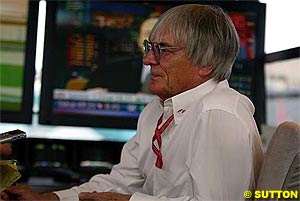 The winter of 2003/04 has been bitter-sweet for the 10 teams. Some, such as Renault and Toyota, have had a brilliant period, benefiting from increased sponsorship, huge currency gains and the GPWC/SLEC settlement. For those two teams it has been all good news. For teams like McLaren Mercedes the opposite is true. Sponsorship is leaking away and the dollar weakness has created a huge cash deficit. Minnows Jordan and Minardi face the same struggle mitigated by an upturn in the rent-a-driver market on which both teams now depend. The other teams have all had middling off-seasons, distressed by the dollar but comforted by the GPWC/SLEC settlement.
The winter of 2003/04 has been bitter-sweet for the 10 teams. Some, such as Renault and Toyota, have had a brilliant period, benefiting from increased sponsorship, huge currency gains and the GPWC/SLEC settlement. For those two teams it has been all good news. For teams like McLaren Mercedes the opposite is true. Sponsorship is leaking away and the dollar weakness has created a huge cash deficit. Minnows Jordan and Minardi face the same struggle mitigated by an upturn in the rent-a-driver market on which both teams now depend. The other teams have all had middling off-seasons, distressed by the dollar but comforted by the GPWC/SLEC settlement.
Team
Cash
Non-Cash
Total
Percent of
Total BudgetPercent of
Ferrari Budget
1
Ferrari
$302.85
$33.35
$336.20
14.68%
100.00%
2
Toyota
$252.90
$68.25
$321.15
14.02%
95.52%
3
McLaren Mercedes
$186.55
$126.95
$313.50
13.69%
93.25%
4
Renault
$192.65
$108.15
$300.80
13.13%
89.47%
5
BMW Williams
$165.30
$111.01
$276.31
12.07%
82.19%
6
BAR Honda
$130.10
$114.10
$244.20
10.66%
72.64%
7
Jaguar Cosworth
$109.45
$119.55
$229.00
10.00%
68.11%
8
Sauber Petronas
$104.90
$37.53
$142.43
6.22%
42.36%
9
Jordan Ford
$55.35
$20.85
$76.20
3.33%
22.67%
10
Minardi Cosworth
$47.35
$2.99
$50.34
2.20%
14.97%
TOTAL
$1,547.40
$742.73
$2,290.13
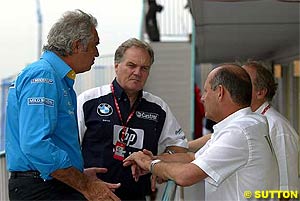 There is no denying that, eliminating special factors, Formula One is in a state of slow financial decay and has been since late 2001. First it was the 11th September effect, then the 2002 Ferrari domination season, that effectively did Formula One in. At the time, Michael Schumacher's antics at Austria and America seemed to blow over. But in reality, they did some semi-permanent damage to the sport, as spectators bowed out, sponsors cashed out and viewers tuned out.
There is no denying that, eliminating special factors, Formula One is in a state of slow financial decay and has been since late 2001. First it was the 11th September effect, then the 2002 Ferrari domination season, that effectively did Formula One in. At the time, Michael Schumacher's antics at Austria and America seemed to blow over. But in reality, they did some semi-permanent damage to the sport, as spectators bowed out, sponsors cashed out and viewers tuned out.
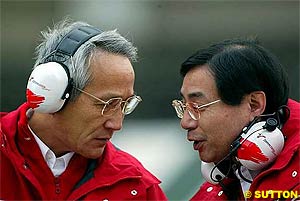 The Formula One community is not noticing this decline as we might because the world's motor manufacturers have rushed in and are taking up the slack. And some invisible slack as well. So many sponsors are now in Formula One not because they want to be but because the car-makers are such big customers that they are afraid not to pump millions into their teams. The car-makers and these sponsors want some bang for their buck, i.e. they want to sell cars and related products to the fans. But because of the accessibility problem they are not selling as many as they might.
The Formula One community is not noticing this decline as we might because the world's motor manufacturers have rushed in and are taking up the slack. And some invisible slack as well. So many sponsors are now in Formula One not because they want to be but because the car-makers are such big customers that they are afraid not to pump millions into their teams. The car-makers and these sponsors want some bang for their buck, i.e. they want to sell cars and related products to the fans. But because of the accessibility problem they are not selling as many as they might.
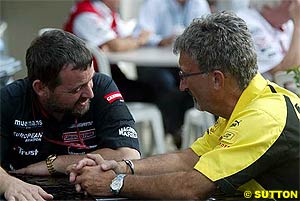 Mosley's chief concern for Formula One in 2004 is to control ultimate speed. The tracks of the world have a safety limit and by all accounts that is the 130mph average lap speed. Once speeds creep above this level, even by a few percentage points, Formula One becomes dangerous. Few doubt Mosley has done enough in 2004 to decrease ever rising speeds, but that will not become apparent until later in the season. If he hasn't, then some drastic mid-season measures may be required. The balance between speed and safety is a very delicate one.
Mosley's chief concern for Formula One in 2004 is to control ultimate speed. The tracks of the world have a safety limit and by all accounts that is the 130mph average lap speed. Once speeds creep above this level, even by a few percentage points, Formula One becomes dangerous. Few doubt Mosley has done enough in 2004 to decrease ever rising speeds, but that will not become apparent until later in the season. If he hasn't, then some drastic mid-season measures may be required. The balance between speed and safety is a very delicate one.
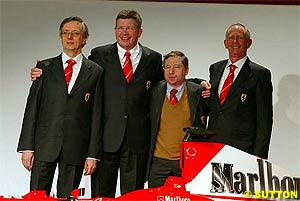 Formula One in the 21st century has a distinct pecking order, with three clear divisions of performance. Ferrari, BMW Williams, McLaren Mercedes and Renault, promoted from the second division, occupy the top flight. In the second division sit BAR Honda, Sauber Petronas, Jaguar and Toyota. In the third division there are just Jordan and Minardi, after Arrows and Prost were permanently relegated. Until recently Jordan raced in the second division. Jaguar was promoted from the third division last season.
Formula One in the 21st century has a distinct pecking order, with three clear divisions of performance. Ferrari, BMW Williams, McLaren Mercedes and Renault, promoted from the second division, occupy the top flight. In the second division sit BAR Honda, Sauber Petronas, Jaguar and Toyota. In the third division there are just Jordan and Minardi, after Arrows and Prost were permanently relegated. Until recently Jordan raced in the second division. Jaguar was promoted from the third division last season.
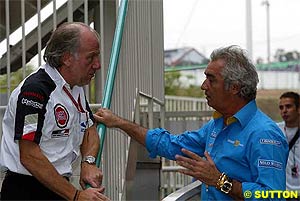 Flavio Briatore has metamorphosed into a first-rate manager. Of Patrick Head, Ron Dennis and Jean Todt there has never been doubt. David Richards and Tony Purnell, meanwhile, are the first of a new breed of 100 per cent sensible managers, although the jury is out on whether that brand of management can survive. Good sense and Formula One have not always been perfect bedfellows. Peter Sauber has proved the independent decent man can still prosper, whilst Tsutomu Tomita at Toyota is still finding his feet, though no one expects him to fail.
Flavio Briatore has metamorphosed into a first-rate manager. Of Patrick Head, Ron Dennis and Jean Todt there has never been doubt. David Richards and Tony Purnell, meanwhile, are the first of a new breed of 100 per cent sensible managers, although the jury is out on whether that brand of management can survive. Good sense and Formula One have not always been perfect bedfellows. Peter Sauber has proved the independent decent man can still prosper, whilst Tsutomu Tomita at Toyota is still finding his feet, though no one expects him to fail.
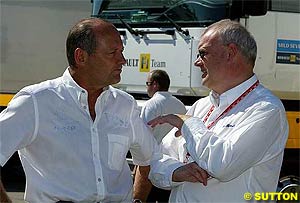 Three technical managers dominate Formula One: Patrick Head at BMW Williams; Adrian Newey at McLaren Mercedes; and Ross Brawn at Ferrari. It is no surprise that these are the technical directors of the big three teams. Below them Mike Gascoyne is the highest regarded, at Toyota, whilst Geoff Willis at BAR Honda is also rising. These five are the stars.
Three technical managers dominate Formula One: Patrick Head at BMW Williams; Adrian Newey at McLaren Mercedes; and Ross Brawn at Ferrari. It is no surprise that these are the technical directors of the big three teams. Below them Mike Gascoyne is the highest regarded, at Toyota, whilst Geoff Willis at BAR Honda is also rising. These five are the stars.
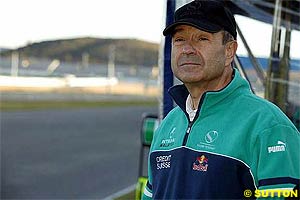 The game this year has been transformed by two external factors of which the teams have no control. The first is the weak dollar crisis, which has been a massive negative for most teams. It was pure happenstance that Toyota and Renault long ago consigned the dollar to history and switched to the euro.
The game this year has been transformed by two external factors of which the teams have no control. The first is the weak dollar crisis, which has been a massive negative for most teams. It was pure happenstance that Toyota and Renault long ago consigned the dollar to history and switched to the euro.
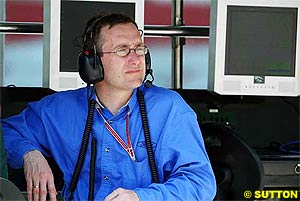 All in all, an extra US$240 million cash will be pumped into the teams in 2004 on top of the US$174 million they were already scheduled to receive. In total FOM will pay out US$414 million to the teams, some 70 per cent of its income for 2004. In later years the teams will receive a combined payout of US$314 million.
All in all, an extra US$240 million cash will be pumped into the teams in 2004 on top of the US$174 million they were already scheduled to receive. In total FOM will pay out US$414 million to the teams, some 70 per cent of its income for 2004. In later years the teams will receive a combined payout of US$314 million.
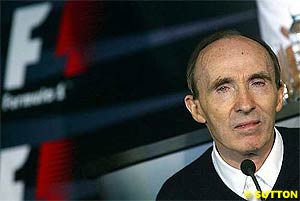 The 2004 season sees some significant new rules, all of which make relative sense and should help enhance the spectacle of Formula One. First is the single engine rule. The chief benefit of this should be increased unreliability; an enduring problems since 2001 has been the reliability of the top teams, especially Michael Schumacher's Ferrari.
The 2004 season sees some significant new rules, all of which make relative sense and should help enhance the spectacle of Formula One. First is the single engine rule. The chief benefit of this should be increased unreliability; an enduring problems since 2001 has been the reliability of the top teams, especially Michael Schumacher's Ferrari.
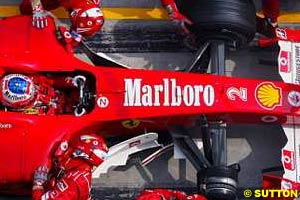 It has become obvious in recent years that much more attention could be paid to the rules without making Formula One more expensive. Gearbox costs have raced away, for no good reason. There is a case for standardising the material gearbox cases can be built in as aluminium. There need be no more than six gears and the gearbox should have its own minimum weight. Equally small fortunes are being spent knocking 1kg off the weight of an engine. Engines should be a minimum weight to end this unnecessary expense, which can only be justified on the spin-off technology it generates for road cars. But this is now a very thin reason. Road car gearboxes are never going to be built out of titanium, although aluminium is a real, if unlikely, option.
It has become obvious in recent years that much more attention could be paid to the rules without making Formula One more expensive. Gearbox costs have raced away, for no good reason. There is a case for standardising the material gearbox cases can be built in as aluminium. There need be no more than six gears and the gearbox should have its own minimum weight. Equally small fortunes are being spent knocking 1kg off the weight of an engine. Engines should be a minimum weight to end this unnecessary expense, which can only be justified on the spin-off technology it generates for road cars. But this is now a very thin reason. Road car gearboxes are never going to be built out of titanium, although aluminium is a real, if unlikely, option.
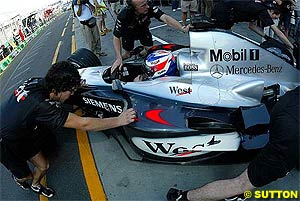 Most makes have sculpted their sidepods but have missed the opportunity to change their function from radiator shroud to aerofoil, something Renault have done so comprehensively.
Most makes have sculpted their sidepods but have missed the opportunity to change their function from radiator shroud to aerofoil, something Renault have done so comprehensively.
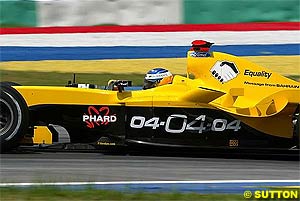 It seems certain that everyone is now in the 100-kilo weight range, 18,500 revs range and, at worst, the 870 horsepower range, which is expected to be maintained in 2004 due to the long-life 800km rule.
It seems certain that everyone is now in the 100-kilo weight range, 18,500 revs range and, at worst, the 870 horsepower range, which is expected to be maintained in 2004 due to the long-life 800km rule.
|
Volume 10, Issue 12
Atlas F1 Exclusive
The Business of Formula One 2004
Interview with Christian Klien
Bjorn Wirdheim: Going Places
Ann Bradshaw: Point of View
2004 Malaysian GP Review
2004 Malaysian GP Review
Technical Review: Malaysia
Buttoned Up
Stats Center
Qualifying Differentials
SuperStats
Charts Center
Columns
The F1 Insider
Season Strokes
On the Road
Elsewhere in Racing
The Weekly Grapevine
> Homepage |
